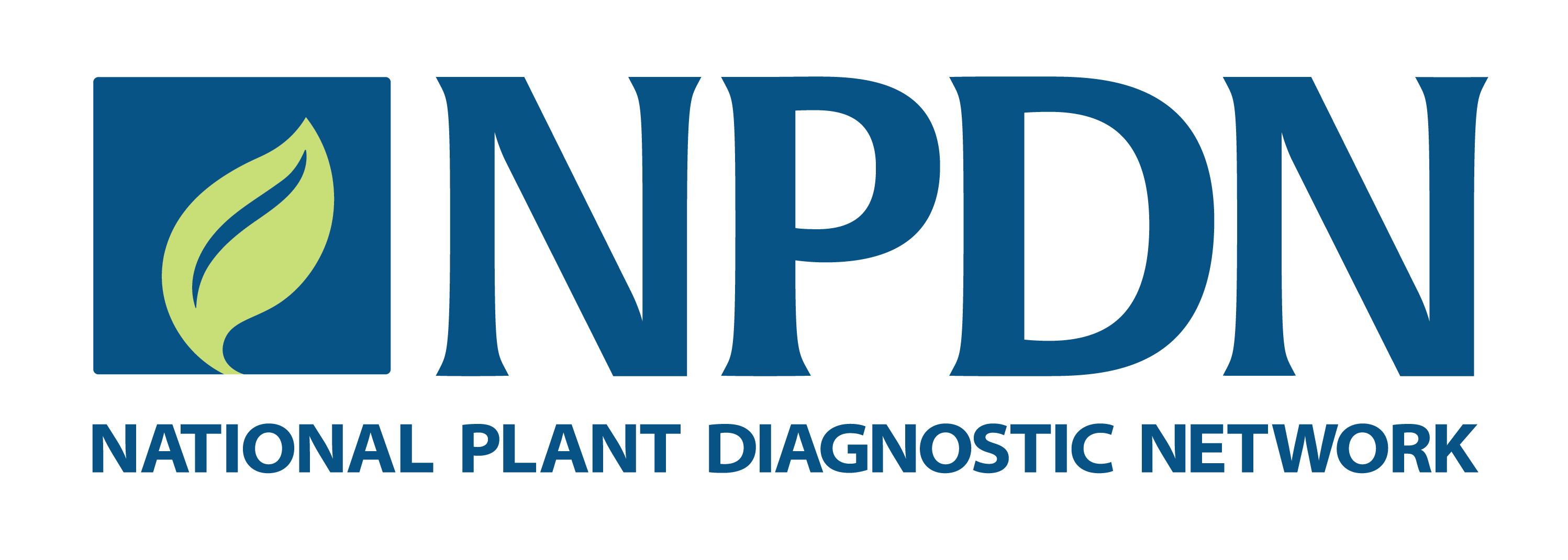Sara R. May, The Pennsylvania State University; Lina Rodriguez Salamanca, Iowa State University; and David M. Geiser, The Pennsylvania State University
Fusarium species include some of the most common and important fungal plant pathogens. Many plants are susceptible to at least one Fusarium-caused disease, with numerous hosts being susceptible to multiple Fusarium species. Morphological identification of Fusarium to currently recognized species is challenging. Multiple species can be associated with the same symptoms. For example, corn stalk rots are caused by F. graminearum, F. verticillioides, F. proliferatum, and F. subglutinans. In other instances, different formae speciales of the same species can cause different symptoms on the same host as with Fusarium crown and root rot of tomato caused by F. oxysporum f. sp. radicis-lycopersici versus Fusarium wilt of tomato caused by F. oxysporum f. sp. lycopersici.
Confident morphological identification of Fusarium to species can be exceedingly difficult. However, careful observation of key morphological characters can easily rule out many species and permit identification to a diagnostically meaningful taxon which may or may not represent a real species. Accurate identification of species and formae speciales may require a combination of morphological and molecular methods, in addition to pathogenicity testing, which will be discussed in another P&V tip. Common plant pathogenic Fusarium species and a few secondary invaders commonly encountered in North America are listed in Table 1.
Fusarium grows easily on a lot of media, including potato dextrose agar (PDA); however, it can be easily outcompeted by other fungi. Therefore, using a selective media such as modified Nash-Snyder medium is recommended for isolations. Single spore or hyphal tip isolates are recommended for identification using morphology and/or molecular methods.
Researchers from Penn State are working with the NPDN Professional Development committee to develop a survey to evaluate Fusarium identification techniques in diagnostic labs and assess training and educational needs for diagnosticians. Watch for more information on this survey in the near future.
Researchers from Penn State are working with the NPDN Professional Development committee to develop a survey to evaluate Fusarium identification techniques in diagnostic labs and assess training and educational needs for diagnosticians. Watch for more information on this survey in the near future.
EPPO. 2019. PM 7/91 (2) Fusarium circinatum (formerly Gibberella circinata). EPPO Bull. 49: 228-247. https://doi.org/10.1111/epp.12587
Leslie, J.F., and Summerell, B.A. 2006. The Fusarium Laboratory Manual. Blackwell Publishing, Ames, IA.
Munkvold, G. 2017. Fusarium species and their associated mycotoxins. Methods in molecular biology. 1542:51-106. doi: 10.1007/978-1-4939-6707-0_4
Nash, S.M., and Snyder, W.C. 1962. Quantitative estimations by plate counts of propagules of the bean root rot Fusarium in field soils. Phytopathology 53:567-572.
Nelson, P.E., Toussoun, T.A., and Marasas, W.F.O. 1983. Fusarium Species: An Illustrated Manual for Identification. The Pennsylvania State University Press, University Park, PA (out of print).
Summerell, B.A., Salleh, B., Leslie, J. F. 2003. A utilitarian approach to Fusarium identification. Plant Disease 87:117-128. https://doi.org/10.1094/PDIS.2003.87.2.117
Fusarium species include some of the most common and important fungal plant pathogens. Many plants are susceptible to at least one Fusarium-caused disease, with numerous hosts being susceptible to multiple Fusarium species. Morphological identification of Fusarium to currently recognized species is challenging. Multiple species can be associated with the same symptoms. For example, corn stalk rots are caused by F. graminearum, F. verticillioides, F. proliferatum, and F. subglutinans. In other instances, different formae speciales of the same species can cause different symptoms on the same host as with Fusarium crown and root rot of tomato caused by F. oxysporum f. sp. radicis-lycopersici versus Fusarium wilt of tomato caused by F. oxysporum f. sp. lycopersici.
Confident morphological identification of Fusarium to species can be exceedingly difficult. However, careful observation of key morphological characters can easily rule out many species and permit identification to a diagnostically meaningful taxon which may or may not represent a real species. Accurate identification of species and formae speciales may require a combination of morphological and molecular methods, in addition to pathogenicity testing, which will be discussed in another P&V tip. Common plant pathogenic Fusarium species and a few secondary invaders commonly encountered in North America are listed in Table 1.
Isolation
Modified Nash-Snyder medium is a selective medium recommended for isolating Fusarium. This medium uses pentachloronitrobenzene (PCNB), typically in the form of the fungicide Terrachlor 75 WP, which may be difficult to find. The fungicide Quintozene is a similar formulation that can be used instead of Terrachlor. Quintozene can currently be purchased in 250 mg quantities from Millipore Sigma. Nash and Snyder first described the Nash-Snyder medium in 1962 and a slightly modified version was described by Nelson et al. 2003. This medium recipe and recipes for other selective media and media for observing morphological characters for identification, are described in the Fusarium guides listed in the reference section (Leslie and Summerell 2006; Nelson et al. 2003).Fusarium grows easily on a lot of media, including potato dextrose agar (PDA); however, it can be easily outcompeted by other fungi. Therefore, using a selective media such as modified Nash-Snyder medium is recommended for isolations. Single spore or hyphal tip isolates are recommended for identification using morphology and/or molecular methods.
Morphological Identification Tips
- Sporulation is poor on Nash-Snyder medium, and this medium should not be used for morphological identification.
- Isolates should be grown on both PDA (full strength or as low as ¼ strength) and either carnation leaf agar (CLA) or Spezieller Nährstoffarmer agar (SNA) with sterile pieces of filter paper added to the surface. Morphological characteristics should be observed on CLA or SNA. Color (aerial mycelium, in the medium) and colony characteristics (growth patterns) can be observed on PDA.
- A worksheet can be helpful for documenting morphological characters for identification. An example of a worksheet for morphological characters is shown in Figure 1.
- We focus mostly on one key microscopic characteristic for identification: the formation of microconidia in the aerial mycelium. If microconidia are present, they can form in chains or false heads from conidiophores consisting of a single (mono-) or multiple phialidic openings (polyphialides). It is easiest to observe microconidium attachment by examining the culture dish under a compound microscope with a 10x objective. Images showing microconidia in short and long chains and false heads can be found in Summerell et al. 2003. However, many Fusarium species do not produce microconidia, so macroconidal morphology and other characteristics are required for identification of these species.
- In addition to microconidium formation, examining conidiogenous cells in the aerial mycelium that form microconidia, mesoconidia or macroconidia can be a helpful diagnostic character. These cells develop as either monophialides or both mono- and polyphialides. Both mono- and polyphialides can be branched or unbranched. A polyphialide is a single conidiogenous cell with more than one opening from which conidia form; there will be no septum separating openings. A monophialide has only one pore. Mesoconidia form only from polyphialides. A drawing of these different conidiogenous cell types including branched (ramified) and unbranched (un-ramified) conidiophores can be found in the EPPO diagnostic bulletin for Fusarium circinatum (EPPO 2019).
- Examine the shape and size of macroconidia that are formed in sporodochia since these are more consistent in shape and size compared to aerial macroconidia. Sporodochia are most likely to form on carnation leaf pieces (CLA) or on filter paper (SNA).
- Thick-walled chlamydospores are morphologically diagnostic for many Fusarium species, particularly soil-inhabitants, but production may be inconsistent among isolates. Chlamydospores will usually form on the agar surface on CLA or SNA but may take more than two weeks to form. For other methods to encourage chlamydospore production, see Leslie and Summerell (2006).
Mycotoxins
Fusarium species produce mycotoxins that can be harmful to humans and livestock. The most important of these mycotoxins are trichothecenes that are formed by species causing Fusarium head blight on grain crops and ear and stalk rot on corn, and fumonisins, which are associated with corn ear rot and other diseases on different hosts. There are many publications available, including the ones listed in the reference section that describe different mycotoxins and the Fusarium species that produce them.Workshops and Training
The International Fusarium Laboratory Workshop is held annually to provide training in Fusarium identification. This workshop is usually offered at Kansas State University during odd-numbered years and international locations on even-numbered years. The 2020 and 2021 workshops were canceled due to the COVID-19 pandemic. Visit the workshop website for updates on future workshops https://www.plantpath.k-state.edu/events/fusarium/index.htmlResearchers from Penn State are working with the NPDN Professional Development committee to develop a survey to evaluate Fusarium identification techniques in diagnostic labs and assess training and educational needs for diagnosticians. Watch for more information on this survey in the near future.
References
The International Fusarium Laboratory Workshop is held annually to provide training in Fusarium identification. This workshop is usually offered at Kansas State University during odd-numbered years and international locations on even-numbered years. The 2020 and 2021 workshops were canceled due to the COVID-19 pandemic. Visit the workshop website for updates on future workshops https://www.plantpath.k-state.edu/events/fusarium/index.htmlResearchers from Penn State are working with the NPDN Professional Development committee to develop a survey to evaluate Fusarium identification techniques in diagnostic labs and assess training and educational needs for diagnosticians. Watch for more information on this survey in the near future.
References
Desjardins, A.E. 2006. Fusarium mycotoxins: chemistry, genetics, and biology. APS Press, St Paul, MN.EPPO. 2019. PM 7/91 (2) Fusarium circinatum (formerly Gibberella circinata). EPPO Bull. 49: 228-247. https://doi.org/10.1111/epp.12587
Leslie, J.F., and Summerell, B.A. 2006. The Fusarium Laboratory Manual. Blackwell Publishing, Ames, IA.
Munkvold, G. 2017. Fusarium species and their associated mycotoxins. Methods in molecular biology. 1542:51-106. doi: 10.1007/978-1-4939-6707-0_4
Nash, S.M., and Snyder, W.C. 1962. Quantitative estimations by plate counts of propagules of the bean root rot Fusarium in field soils. Phytopathology 53:567-572.
Nelson, P.E., Toussoun, T.A., and Marasas, W.F.O. 1983. Fusarium Species: An Illustrated Manual for Identification. The Pennsylvania State University Press, University Park, PA (out of print).
Summerell, B.A., Salleh, B., Leslie, J. F. 2003. A utilitarian approach to Fusarium identification. Plant Disease 87:117-128. https://doi.org/10.1094/PDIS.2003.87.2.117

